The universe is a vast expanse filled with celestial bodies that have intrigued and inspired humanity for centuries. From the fiery brilliance of stars to the mysterious allure of distant planets and galaxies, the study of celestial bodies opens a window to the wonders of the cosmos. Let’s embark on a journey of exploration as we delve into the characteristics, classifications, and fascinating phenomena that define the celestial landscape.
Stars: Beacons of the Cosmos
1. The Life Cycle of Stars
Stars, those luminous spheres of burning gas, follow a life cycle that spans millions to billions of years. They begin as nebulous clouds of gas and dust, collapsing under their own gravity. Fusion reactions in their cores produce light and heat, sustaining their brilliance. The fate of a star is determined by its mass, with possibilities ranging from becoming a white dwarf to a supernova or even a black hole.
2. Stellar Spectra and Types
Observing the light emitted by stars reveals a spectrum of colors, indicating their composition and temperature. Stars are categorized into spectral types (O, B, A, F, G, K, M), with O-type stars being the hottest and M-type stars the coolest. Our Sun, a G-type star, falls in the middle of this spectral sequence.
Planets: Worlds in Motion
1. The Solar System
Planets, the celestial bodies that orbit stars, are members of our solar system. From the rocky inner planets (Mercury, Venus, Earth, Mars) to the gas giants in the outer regions (Jupiter, Saturn, Uranus, Neptune), each planet boasts unique characteristics. The dwarf planet Pluto, though no longer considered a full-fledged planet, adds an intriguing dimension to our solar neighborhood.

2. Exoplanets: Beyond Our Solar System
Advancements in technology have allowed astronomers to discover thousands of exoplanets orbiting stars beyond our sun. These distant worlds vary in size, composition, and orbital patterns, expanding our understanding of planetary systems throughout the galaxy.
Galaxies: Cosmic Cities of Stars
1. Classification of Galaxies
Galaxies are vast collections of stars, gas, dust, and dark matter bound together by gravity. They come in various shapes and sizes, ranging from spiral galaxies like the Milky Way to elliptical and irregular galaxies. The study of galaxies provides insights into the large-scale structure and evolution of the universe.
2. Black Holes: Celestial Mysteries
At the heart of many galaxies lurk black holes—regions with gravitational forces so strong that nothing, not even light, can escape. Black holes are formed through the collapse of massive stars or the merging of smaller black holes. Their existence poses profound questions about the nature of space and time.
Cosmic Phenomena: Nebulae, Supernovae, and More
1. Nebulae: Cosmic Clouds of Creation
Nebulae are vast clouds of gas and dust, often illuminated by nearby stars or undergoing the process of star formation. These cosmic nurseries give birth to new stars and planetary systems.
2. Supernovae: Explosive Endings
The explosive death of massive stars results in supernovae, releasing energy equivalent to the brightness of entire galaxies. These cataclysmic events disperse heavy elements into space, contributing to the formation of future stars and planets.
The Future of Celestial Exploration
1. Telescopes and Space Probes
Technological advancements in telescopes, both ground-based and space-based like the Hubble Space Telescope, continue to deepen our understanding of celestial bodies. Robotic space probes, such as the Voyager and Juno missions, venture into the outer reaches of our solar system, unraveling mysteries and sending back invaluable data.

2. Unraveling Dark Matter and Dark Energy
The nature of dark matter and dark energy, which together make up about 95% of the universe, remains one of the greatest mysteries in astrophysics. Ongoing and future missions, like the James Webb Space Telescope, aim to shed light on these enigmatic cosmic components.
Conclusion
Understanding celestial bodies is a journey that expands our comprehension of the cosmos. From the birth and death of stars to the intricate dance of planets and the vastness of galaxies, each celestial entity contributes to the tapestry of the universe. As we peer deeper into the cosmos, the mysteries and wonders that await promise to captivate the imagination of generations to come. Embrace the beauty of the night sky, and let the celestial bodies inspire your curiosity and awe.

